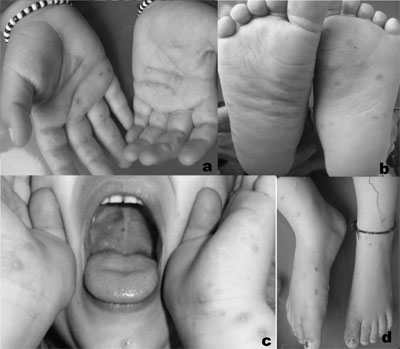|
|
|
Indian Pediatr 2014;51: 155 |
 |
Hand-foot-mouth Disease: Outbreak in Shimla
|
|
Subhash Kashyap and GK Verma
Department of Dermatology, Venereology and Leprosy,
Indira Gandhi Medical College,
Shimla, Himachal Pradesh, India.
Email: drskash@gmail.com
|
|
Hand, foot, and mouth disease (HFMD) is generally a benign
and self-limiting disease affecting mainly children below
five years of age. It is commonly caused by coxsackievirus
A16 (CVA16) and human enterovirus 71 (HEV71), and rarely by
other members of picornaviridae family [1]. We report an
outbreak of HFMD in Shimla, Himachal Pradesh.
Forty seven (27 males) patients of HFMD
were registered in the dermatology outpatient department at
a tertiary hospital, within a period of two months (July to
August 2013). Thirty six (76.5%) patients were children
below the age of five years (mean, 3.2 yrs); twenty five
from a single kindergarten in the city. Five adults (age
range 30 to 47 years), who were parents of affected
children, were also registered. Skin lesions were grayish-white
vesicles, elliptical to round in shape and surrounded by an
erythematous halo. Oral involvement was in the form of
shallow and irregular ulcers with a yellowish-grey base and
erythematous margins. Oral involvement and typical lesions
on hands and feet were seen in all cases. A prodrome of mild
to moderate fever, anorexia, malaise, dysphagia and
arthralgia was seen in 24 (51%) cases (Fig. 1).
Palms were found to be the most common (n=36, 76.6%)
site of involvement followed by dorsa of hands (n=26,
53%), soles (n=15, 25%), elbows (n=14, 29.8%)
and buttocks (n=5, 1.1%). The buccal mucosa was the
most common site (n=39, 82.9%) of intraoral
involvement followed by palate (n=20, 42.5%), tongue
(n=11, 23.4%), gingiva (n=9, 19.1%) and lips (n=6,
1.3%). No complication was noted in any case. All were
treated symptomatically and lesions subsided within about a
week without any sequelae.
 |
|
Fig. 1 Grayish vesicles
with erythematous halo on (a) palmar aspects of
hands (b) soles (c) hands and palate, and (d) dorsa
of feet.
|
Whereas CV/A16 infection is almost always
mild, enterovirus type 71 associated HFMD may be rarely
severe with encephalitis, acute flaccid paralysis,
myocarditis, pulmonary edema, and even death [2,3].
Some small outbreaks over the years were
followed by fatal epidemics in China, Taiwan and Malaysia
[4]. Although no death from HFMD is reported from India
since its first report in 2003 but similar trends may be
followed in a genetically susceptible population [1]. There
is an urgent need to increase the awareness level among
healthcare professionals to diagnose HFMD.
References
1. Sarma N. Hand, foot, and mouth
disease: Current scenario and Indian perspective. Indian J
Dermatol Venereol Leprol. 2013;79:165-75.
2. Huang WC, Huang LM, Lu CY, Cheng AL,
Chang LY. Atypical hand-foot-mouth disease in children: a
hospital-based prospective cohort study. Virol J.
2013;10:209.
3. Zhang Y, Zhu Z, Yang WZ, Ren J, Tan
XJ, Wang Y, et al. An emerging recombinant human
enterovirus 71 responsible for the 2008 outbreak of hand
foot and mouth disease in Fuyang city of China. Virol J.
2010;7:94.
4. Shin JU, Oh SH, Lee JH. A case of hand-foot-mouth
disease in an immunocompetent adult. Ann Dermatol.
2010;22:216-8.
|
|
|
 |
|

